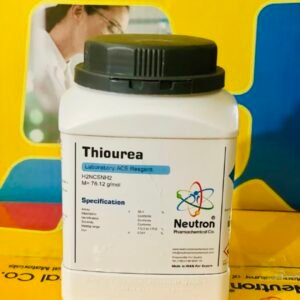کربن تتراکلراید
| Chemical formula | CCl4 |
| Density | 1.59 g/cm3 |
| Molar mass | 153.82 g/mol |
| CAS number | 56-23-5 |
| HS Code | 29032200 |
| EC number | 200-262-8 |
| Storage | Store at 15 to +30 °C |
| SDS | available |
| R Phrase | R 23/24/25,R40,R48/23, |
| S Phrase | S 36/37,S45,S59,S61 |
| Form | liquid |
| Color | colorless |
| Ignition temperature | 982 °C |
| Vapor pressure | 11.94 hPa (20°C) |
| Melting point | – 22.92 °C |
| Boiling point | 76.72 °C |
| Assay | ≥ | 99.5 | % |
| Description | Conforms | ||
| Identification | Conforms | ||
| Evaporation residue | ≤ | 0.0003 | % |
| Water | ≤ | 0.005 | % |
Carbon tetrachloride is a clear, volatile, and heavy liquid compound widely used in chemical laboratories, particularly known for its historical use as a solvent and its role in organic synthesis and analytical chemistry.
🏭⚗️ Production
Carbon tetrachloride is typically produced by the chlorination of methane or carbon disulfide. In industrial settings, methane reacts with excess chlorine gas at high temperatures in the presence of a catalyst, forming carbon tetrachloride along with other chlorinated byproducts like chloroform.
🔬 Properties
The chemical formula is CCl₄, with a molar mass of approximately 153.82 g/mol. Carbon tetrachloride is a colorless, non-flammable liquid with a sweet, chloroform-like odor. It is insoluble in water but miscible with most organic solvents. It has a boiling point of 76.7 °C, a melting point of −22.9 °C, and a density of 1.59 g/cm³ at 20 °C. Being a tetrahalomethane, it is chemically stable and does not readily react with acids or bases under normal conditions.
🧪 Applications
In laboratory contexts, carbon tetrachloride has been used as a non-polar solvent for fats, oils, and other organic compounds. It also plays a role in infrared spectroscopy and NMR analysis due to its lack of hydrogen atoms. Historically, it was used as a cleaning agent and in pharmaceutical manufacturing as a solvent, although such uses have been largely discontinued due to toxicity. In organic synthesis, it can act as a reagent in halogenation reactions and the preparation of carbon tetrachloride-derived compounds.
⚠️ Safety
Carbon tetrachloride is highly toxic and potentially carcinogenic. Inhalation or ingestion can cause liver and kidney damage, central nervous system depression, and may be fatal in large doses. Chronic exposure is associated with hepatotoxicity, and it is classified as a Group 2B carcinogen by IARC. It should be handled with extreme care in well-ventilated fume hoods, using gloves and eye protection. It is also ozone-depleting, and its use is strictly regulated or banned in many countries.



